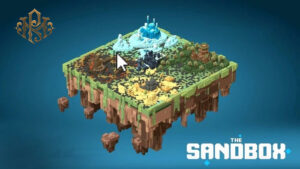
Close



In the field of digital currencies and the virtual world, the concept of Metaverse has captured the imagination of millions of people around the world. In this growing landscape, Sandbox stands out as one of the most prominent and widespread games in the Metaverse. Using blockchain technology and having its own native digital currency, Sandbox gives users the opportunity to explore, create and monetize virtual experiences. This article serves as a comprehensive guide to the sandbox cryptocurrency, providing insights into its origins, features, and the wider world.
A sandbox is a decentralized virtual world where players can create, own, and monetize their gaming experiences. Developed by Pixowl, a subsidiary of Animoca Brands, Sandbox uses blockchain technology to provide real ownership of digital assets and experiences within its ecosystem. Launched in 2012 as a mobile game, Sandbox has since grown into a multi-platform metaverse game, attracting millions of users and creators from around the world.

User Generated Content: At the heart of Sandbox is the concept of user generated content. Players have the freedom to create and customize their virtual world using a variety of tools and assets provided by the platform. From building structures to designing scenery and scripting gameplay mechanics, Sandbox allows users to unleash their creativity and bring their ideas to life.
Blockchain Integration: Sandbox uses blockchain technology, specifically non-fungible tokens (NFTs), to enable real ownership of digital assets in the game. Any virtual asset, be it a piece of land, a character, or an item, is represented as an NFT on the blockchain, allowing players to buy, sell, and trade their creations transparently and decentralized.
Game Monetization Mechanics: In line with the emerging trend of game monetization, Sandbox offers players the opportunity to monetize their gaming experiences through a variety of methods. By creating and selling virtual assets, participating in gameplay challenges and interacting with the community, players can earn rewards in the form of the platform’s native digital currency.
Social Interaction: Sandbox fosters a vibrant and inclusive community where players can connect, collaborate and socialize with like-minded people. Whether it’s participating in virtual events, joining forums, or visiting each other’s work, Sandbox provides plenty of opportunities for social interaction and networking in its inclusive world.
Metaverse Economy: As part of the larger Metaverse ecosystem, Sandbox helps develop a digital economy where virtual assets have real value. Through its marketplace and trading platform, players can buy, sell and speculate on digital assets, creating new opportunities for investment and entrepreneurship in the digital age.
The core of the sandbox ecosystem is its native digital currency known as Sand. The document acts as the primary medium of exchange and transfer of value on the platform, facilitating economic transactions, incentivizing participation and stimulating the growth of the Metaphors economy. The key aspects of digital currency are:
Utility: SAND is used in various aspects of the sandbox ecosystem, including purchasing virtual land, acquiring assets and resources, participating in gameplay mechanics, and interacting with the community. As the main currency of the platform, the document plays a vital role in enabling economic activity and creating value in the metaverse.
Governance: Document holders have the opportunity to participate in governance and decision-making processes in the sandbox ecosystem. Through decentralized governance mechanisms such as voting and proposals, token holders can influence the platform’s direction, shape its policies, and contribute to its long-term success and sustainability.
Equity and Rewards: Sandbox rewards active participants and stakeholders through various incentive mechanisms, including equity and cash mining. By placing document tokens, users can earn rewards such as additional tokens, governance rights, and access to exclusive features and privileges on the platform.
Economic model: The design of the Sandbox economic model is based on the usefulness and accrual value of the digital currency of the document. As the demand for virtual assets and experiences on the platform increases, the value of document tokens is expected to increase, encouraging greater participation, investment and adoption.
Sandbox offers a wide range of use cases and applications for players, creators, developers and investors alike. Some notable uses of Sandbox cryptocurrency include:
Virtual Land Ownership: Players can use Sand Tokens to purchase and own virtual land pieces in the Sandbox Metaverse. Owners have the freedom to develop and monetize their land by building and renting out virtual experiences to other players.
Asset acquisition: The document can be used to acquire virtual assets, such as characters, decorations, from the sandbox market. These assets can be used to enhance gameplay experiences, customize virtual worlds, and create immersive narratives.
Participation in governance: Document holders can actively participate in governance and decision-making processes in the sandbox ecosystem. By placing document tokens and voting on proposals, users can shape the development and future direction of the platform.
Monetization and Rewards: Creators and developers can monetize their creations and earn rewards in Document Tokens through various methods, including asset sales, gameplay challenges, and social events. This incentivizes content creation, fosters innovation, and rewards participation on the platform.

Despite the potential of the sandbox and its native digital currency, they face various challenges and considerations, including:
Scalability: As the sandbox ecosystem continues to grow in popularity and user adoption, scalability becomes an important consideration. Ensuring that the platform can handle growing transaction volumes and maintain optimal performance is essential to its long-term viability and success.
User Experience: Providing an intuitive and seamless user experience is very important to attract and retain users in Metaverse Sandbox. Improving usability, accessibility, and installation processes can help lower barriers to entry and increase user engagement and satisfaction.
Regulatory Compliance: Navigating the regulatory landscape around blockchain-based virtual worlds and digital currencies requires careful scrutiny and compliance measures. Addressing legal and regulatory challenges, such as taxation, licensing, and consumer protection, is necessary to mitigate risks and ensure compliance with relevant laws and regulations.
Security and Trust: Maintaining the security and integrity of the sandbox ecosystem is critical to building trust and confidence among users and stakeholders. Implementing strong security measures, such as encryption, authentication and auditing, can help protect against threats and vulnerabilities, protecting assets and user data.
Despite these challenges, Sandbox and its native cryptocurrency are well positioned to capitalize on the growing demand for immersive virtual experiences and decentralized economies. As the Metaverse continues to evolve and expand, Sandbox is at the forefront of innovation, bringing together gaming, blockchain, and cryptocurrencies. With its vibrant community, diverse ecosystem and pioneering spirit, Sandbox is poised to redefine the future of play, work and social interaction in the digital age.
Sandbox represents a groundbreaking innovation in the field of digital currencies and virtual worlds that gives users the opportunity to discover, create and monetize immersive experiences in a decentralized space. With its user-generated content, blockchain integration, and native digital currency, Sandbox enables individuals and communities to unleash their creativity, express themselves, and participate in a thriving economy. As the metamorphosis continues.